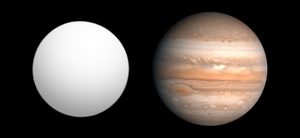Kepler-9b
| Exoplanet | List of exoplanets | |
|---|---|---|
 |
||
| Parent star | ||
| Star | Kepler-9 | |
| Constellation | Lyra | |
| Right ascension | (α) | 19h 2m 17.76s |
| Declination | (δ) | +38° 24′ 3.2″ |
| Apparent magnitude | (mV) | ~13 |
| Distance | 2120 ly (650 pc) |
|
| Mass | (m) | 1.07 M☉ |
| Radius | (r) | 1.02 R☉ |
| Temperature | (T) | 5777 ± 61 K |
| Metallicity | [Fe/H] | +0.12 ± 0.04 |
| Age | ~1 Gyr | |
| Physical characteristics | ||
| Mass | (m) | 0.252 ± 0.013 MJ |
| Radius | (r) | 0.842 ± 0.069 RJ |
| Orbital elements | ||
| Semi-major axis | (a) | 0.140 ± 0.001 AU |
| Eccentricity | (e) | 0 |
| Orbital period | (P) | 19.24 d |
| Inclination | (i) | 88.55° |
| Discovery information | ||
| Discovery date | 26 August 2010 | |
| Discoverer(s) | Kepler Mission team | |
| Discovery method | Transit (Kepler Mission) | |
| Other detection methods | Radial velocity Transit timing variations |
|
| Discovery status | Announced | |
Kepler-9b is one of the first planets discovered outside the solar system (exoplanets) by NASA's Kepler Mission. It revolves around the star Kepler-9 within the constellation Lyra. Kepler-9b is the largest of three planets detected in the Kepler system by transit method; its mass is slightly smaller than the planet Saturn, and it is the largest planet in its system. Kepler-9b and Kepler-9c display a phenomenon called orbital resonance, in which gravitational pull from each planet alters and stabilizes the orbit of the other. The planet's discovery was announced on August 26, 2010.
Kepler-9b's name denotes that it is the first exoplanet discovered in orbit around the star Kepler-9. The star, in turn, was named for the Kepler Mission, a NASA project designed to search for Earth-like planets. Kepler-9's planets were among 700 planetary candidates collected during Kepler's first 43 days online. The system in particular was flagged as one of five systems that appeared to have held more than one transiting exoplanet. Kepler-9b's discovery was announced on August 26, 2010. It was the part of the first confirmed star system in which multiple planets transited the same star.
The planet was confirmed by the Kepler satellite by the transit method, in which the planet passes across the face of its star in relation to Earth, dimming that star's light by a small amount; this light difference is then used to determine the planet and several of its characteristics, including size and distance from its home star.
Initial estimates for Kepler-9b's mass were refined by the W. M. Keck Observatory at Mauna Kea, Hawaii. In doing so, scientists found that Kepler-9b is the larger of the two gas planets discovered in the Kepler-9 system, although in mass it is smaller than planet Saturn.
...
Wikipedia
